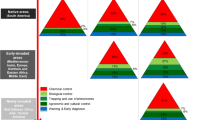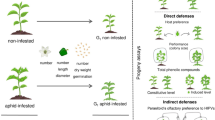Abstract
Tests for antibiosis and antixenosis resistance to Rhopalosiphum padi L., the bird cherry-oat aphid, were conducted among four wheat (Triticum aestivum L.) and eight triticale (XTriticosecale Wittmack) accessions. Tests for antibiosis included measuring R. padi-population growth over 13 days, number of days to reproduction of individual R. padi, and number of aphid progeny produced in the first 7 days of adulthood. Antixenosis was measured in no-choice nymphiposition tests and in choice tests of host selection by winged R. padi. Three of seven triticale accessions limited R. padi populations relative to control accessions. Lower R. padi-population growth on N1185 and Okto Derzhavina could be explained partially by increased developmental times. Lower R. padi-population growth on triticale accessions N1185, N1186 and Okto Derzhavina could be explained at least partially by fewer aphid progeny on these accessions. Developmental time of R. padi on N1185 and Okto Derzhavina was greater than that on Stniism 3 triticale, identified previously as resistant to R. padi. There were less R. padi progeny on N1185 than on Stniism 3, and comparable numbers of R. padi progeny among N1186, Okto Derzhavina, and Stniism 3. None of the accessions limited nymphiposition by R. padi. Choice tests revealed heterogeneity in host selection by R. padi but an overall trend that triticale accessions Okto Derzhavina, N1185, N1186 and Stniism 3 were less preferred hosts than Arapahoe wheat. Relatively strong resistance in these triticale accessions warrant consideration of their future use in breeding programs for cereal-aphid resistance.
Similar content being viewed by others
References
Adams, J.B. & H.F. van Emden, 1972. The biological properties of aphids and their host plant relationships. In: H.F. van Emden (Ed.), Aphid Technology, pp. 48–104. Academic Press, London.
Baenziger, P.S., J.W. Schmidt, C.J. Peterson, V.A. Johnson, P.J. Mattern, A.F. Dreier, D.V. McVey & J.H. Hatchett, 1989. Arapahoe wheat. Crop Sci 29: 832.
Bauske, E.M., S.M. Bissonnette & A.D. Hewings, 1997. Yield loss assessment of barley yellow dwarf disease on spring oat in Illinois. Phytopathology 81: 485–488.
Blackman, R.L. & V.F. Eastop, 2000. Aphids on the world’s crops, 2nd edn., Wiley, Chichester, England.
Chapin, J.W., J.S. Thomas, S.M. Gray, D.M. Smith & S.E. Halbert, 2001. Seasonal abundance of aphids (Homoptera: Aphididae) in wheat and their role as barley yellow dwarf virus vectors in the South Carolina coastal plain. J Econ Entomol 94: 410–421.
Cholick, F.A., G.W. Buchenau & B.G. Farber, 1992. Registration of Sharp wheat. Crop Sci 32: 282.
Dahms, R.G., 1972. The role of host plant resistance in integrated insect control. In: M.G. Jowanti & W.R. Young (Eds.), The Control of Sorghum Shoot Fly, pp. 152–167. Oxford & IBH Publishers, New Delhi.
Dreyer, D.L. & B.C. Campbell, 1987. Chemical basis of host-plant resistance to aphids. Plant Cell Envir 10: 353–361.
du Toit, F., 1987. Resistance in wheat (Triticum aestivum) to Diuraphis noxia (Homoptera: Aphididae). Cereal Res Commun 15: 175–179.
Elliott, N.C., G.L. Hein & B.M. Shepard, 1994. Sampling arthropod pests of wheat and rice. In: L.P. Pedigo & G.D. Buntin (Eds.), Handbook of Sampling Methods for Arthropods in Agriculture, pp. 627–666. CRC Press, Boca Raton, FL, U.S.A.
Fisher, R.A., 1935. The Design of Experiments, 1st edn., Oliver and Boyd, Edinburgh, Scotland.
Flinn, M., C.M. Smith, J.C. Reese & B. Gill, 2001. Categories of resistance to greenbug (Homoptera: Aphididae) biotype I in Aegilops tauschii germplasm. J Econ Entomol 94: 558–563.
Frank, W.A., R.A. Scott, J.E. Slosser & W.D. Worrall, 1989. Resistance in triticale to Russian wheat aphid and greenbug. Southwest Entomol 14: 167–178.
Fritz, A.K., S. Caldwell & W.D. Worrall, 1999. Molecular mapping of Russian wheat aphid resistance from triticale accession PI 386156. Crop Sci 39: 1707–1710.
Gibson, R.W. & R.T. Plumb, 1977. Breeding plants for resistance to aphid infestation. In: K.F. Harris & K. Maramorosch (Eds.), Aphids and Virus Vectors, pp. 473–500. Academic Press, New York.
Hammon, R.W., C.H. Pearson & F.B. Peairs, 1996. Winter wheat planting date effect on Russian wheat aphid (Homoptera: Aphididae) and a plant virus complex. J Kansas Entomol Soc 69: 302–309.
Herbert, D.A., E.L. Stromberg, G.F. Chappell & S.M. Malone, 1999. Reduction of yield components by barley yellow dwarf virus in Virginia. J Prod Agric 12: 105–109.
Hesler, L.S., 2005. Resistance to Rhopalosiphum padi (Homoptera: Aphididae) in three triticale accessions. J Econ Entomol 98: 603–610.
Hesler, L.S., W.E. Riedell, R.W. Kieckhefer, S.D. Haley & R.D. Collins, 1999. Resistance to Rhopalosiphum padi (Homoptera: Aphididae) in wheat germplasm accessions. J Econ Entomol 92: 1234–1238.
Hesler, L.S., W.E. Riedell, R.W. Kieckhefer & S.D. Haley, 2003. Responses of Rhopalosiphum padi (Homoptera: Aphididae) on cereal aphid-resistant wheat accessions. J Agric Urban Entomol 19: 133–140.
Hesler, L.S., Z. Li, T.M. Cheesbrough & W.E. Riedell, 2005. Nymphiposition and population growth of Rhopalosiphum padi L. (Homoptera: Aphididae) on conventional wheat cultivars and transgenic wheat isolines. J Entomol Sci 39(2): (in press).
Kennedy, G.G., 1976. Host plant resistance and the spread of plant viruses. Environ Entomol 5: 827–832.
Kennedy, G.G., F. Gould, O.M.B. Deponti & R.E. Stinner, 1987. Ecological, agricultural, genetic, and commercial considerations in the deployment of insect-resistant germplasm. Environ Entomol 16: 327–338.
Kieckhefer, R.W. & R.F. Derr, 1967. Rearing three species of cereal aphids on artificial diets. J Econ Entomol 60: 663–664.
Kieckhefer, R.W. & J.L. Gellner, 1992. Yield losses in winter wheat caused by low-density cereal aphid populations. Agron J 84: 180–183.
Kieckhefer, R.W., J.L. Gellner & W.E. Riedell, 1995. Evaluation of the aphid-day standard as a predictor of yield loss caused by cereal aphids. Agron J 87: 785–788.
Kogan, M. & E.E. Ortman, 1978. Antixenosis –a new term proposed to replace Painter’s ‘nonpreference’ modality of resistance. Bull Entomol Soc Am 24: 175–176.
Leather, S.R., K.F.A. Walters & A.F.G. Dixon, 1989. Factors determining the pest status of the bird cherry-oat aphid, Rhopalosiphum padi (L.) (Hemiptera: Aphididae), in Europe: A study and review. Bull Ent Res 79: 345–360.
Littell, R.C., G.A. Milken, W.W. Stroup & R.D. Wolfinger, 1996. SAS® system for mixed models. SAS Institute, Inc., Cary, NC, U.S.A.
McGrath, P.F. & J.S. Bale, 1990. The effects of sowing date and choice of insecticide on cereal aphids and barley yellow dwarf virus epidemiology. Ann Appl Biol 117: 31–43.
Nkongolo, K.K., J.S. Quick, W.L. Meyer & F.B. Peairs, 1989. Russian wheat aphid resistance of wheat, rye, and triticale in greenhouse tests. Cereal Res Commun 17: 227–232.
Nkongolo, K.K., J.S. Quick & F.B. Peairs, 1992. Inheritance of resistance of three Russian triticale lines to the Russian wheat aphid. Crop Sci 32: 689–692.
Nkongolo, K.K., N.L.V. Lapitan & J.S. Quick, 1996. Genetic and cytogenetic analyses of Russian wheat aphid resistance in triticale × wheat hybrids and progenies. Crop Sci 36: 1114–1119.
Painter, W.H., 1951. Insect Resistance in Crop Plants, Macmillan, New York.
Panda, N. & G.S. Khush, 1995. Host Plant Resistance to Insects. CAB International, Oxon, U.K.
Pike, K.S. & R.L. Schaffner, 1985. Development of autumn populations of cereal aphids, Rhopalosiphum padi (L.) and Schizaphis graminum (Rondani) (Homoptera: Aphididae) and their effects on winter wheat in Washington state. J Econ Entomol 78: 676–680.
Power, A.G. & S.M. Gray, 1995. Aphid transmission of barley yellow dwarf viruses: interactions between virus, vectors, and host plants. In: C.J. D’Arcy & P.A. Burnett (Eds.), Barley Yellow Dwarf 40 Years of Progress, pp. 259–289. ARS Press, St. Paul, MN, U.S.A.
Puterka, G.A., J.D. Burd & R.L. Burton, 1992. Biotypic variation in a worldwide collection of Russian wheat aphid (Homoptera: Aphididae). J Econ Entomol 85: 1497–1506.
Riedell, W.E., R.W. Kieckhefer, S.D. Haley, M.A.C. Langham & P.D. Evenson, 1999, Winter wheat responses to bird cherry-oat aphid and barley yellow dwarf virus infection. Crop Sci 39: 158–163.
SAS Institute, 1999. SAS® Proprietary Software, version 8. SAS Institute Inc., Cary, NC, U.S.A.
Schotzko, D.J. & N.A. Bosque-Pérez, 2000. Seasonal dynamics of cereal aphids on Russian wheat aphid (Homoptera: Aphididae) susceptible and resistant wheats. J Econ Entomol 93: 975–981.
Schotzko, D.J. & C.M. Smith, 1991. Effects of preconditioning host plants on population development of Russian wheat aphids ((Homoptera: Aphididae). J Econ Entomol 84: 1083–1087.
Unger, L.M. & S.S. Quisenberry, 1997. Categorization of six wheat plant introduction lines for resistance to the Russian wheat aphid (Homoptera: Aphididae). J Econ Entomol 90: 1408–1413.
Webster, J.A., 1990. Resistance in triticale to the Russian wheat aphid (Homoptera: Aphididae). J Econ Entomol 83: 1091–1095.
Webster, J.A. & C. Inayatullah, 1984. Greenbug (Homoptera: Aphididae) resistance in triticale. Environ Entomol 13: 444–447.
Webster, J.A. & C. Inayatullah, 1988. Assessment of experimental designs for greenbug (Homoptera: Aphididae) antixenosis tests. J Econ Entomol 81: 1246–1250.
Webster, J.A. & P. Kenkel, 1999. Benefits of managing small-grain pests with plant resistance. In: B.R. Wiseman & J.A. Webster (Eds.), Economic, Environmental, and Social Benefits of Resistance in Field Crops, pp. 87–114. Proc Thomas Say Publ Entomol, Entomological Society of America, Lanham, MD, U.S.A.
Wiktelius, S. & B.S. Ekbom, 1985. Aphids in spring sown cereals in central Sweden: Abundance and distribution 1980–1983. Z Ang Entomol 100: 8–16.
Wiktelius, S. & J. Pettersson, 1985. Simulations of bird cherry-oat aphid population dynamics: A tool for developing strategies for breeding aphid-resistant plants. Agric Ecosyst Environ 14: 159–170.
Zar, J.H., 1996. Biostatistical analysis, 3rd edn., Prentice Hall, Upper Saddle River, NJ, U.S.A.
Author information
Authors and Affiliations
Corresponding author
Rights and permissions
About this article
Cite this article
Hesler, L.S., Tharp, C.I. Antibiosis and antixenosis to Rhopalosiphum padi among triticale accessions. Euphytica 143, 153–160 (2005). https://doi.org/10.1007/s10681-005-3060-7
Received:
Accepted:
Issue Date:
DOI: https://doi.org/10.1007/s10681-005-3060-7




